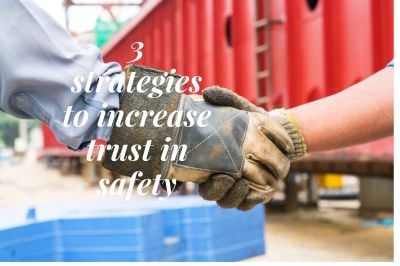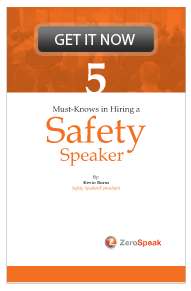3 Strategies To Increase Trust In Safety
You cannot just think of yourself as a quality safety leader and employ low-quality tactics for the safety of your crew.
 An employee not engaged in their work; who mindlessly goes through the motions of their work does not buy-into safety. Gallup says that over 70% of employees in North America are not fully engaged in their work. That spells trouble for safety performance. Safety managers and supervisors, engagement just became your problem.
An employee not engaged in their work; who mindlessly goes through the motions of their work does not buy-into safety. Gallup says that over 70% of employees in North America are not fully engaged in their work. That spells trouble for safety performance. Safety managers and supervisors, engagement just became your problem.
Supervisors and safety managers must participate in management and coaching training courses now. A supervisor or manager who can't help an employee engage in safety is also a job-hazard.
Front-line supervisors and safety people set the tone of “how we do things ‘round here.” They also set the tone of how we safely do things ‘round here. They also influence respect and trust among crew members. Anyone in a position of influence must embrace that responsibility.
Supervisors and safety people who push safety “because it’s the rule” will get small compliance. But, present safety “because you guys are valuable and I don’t want to lose you,” then you’ll get a different response. You build crew members that begin to value their contribution. When employees see that you care about their safety, they’ll care about their safety.
Here are three strategies you can begin to work on to improve your ability to create trust in safety with front-line employees:
1Improve respect. As a supervisor or front-line safety person, you are one of the prime reasons that some crew members will stay and some will leave. The supervisor and safety person can build and destroy loyalty. They are the first line of communication between crew members and company. Supervisors and safety people influence loyalty and turnover through their words and actions. Do it poorly and you turn over staff. Staff turnover creates risk. The longer you can keep your crew working together, the better that their performance will get. Crews leave a poor supervisor but tend to stick with a good one. Safety people can influence the culture too. They can also create hostility and cause turnover. But, when mutual trust and respect are high, turnover is low. Focus on reinforcing mutual trust and respect.
2Show them that you care. Tell employees that their contribution matters. Tell them that they are important, that their lives are valued. Make them want to stick around longer. When employees are told that they are valued, they pay more attention to the choices they make. After all, how do you disappoint someone who has expressed a desire to have you around a long time? How do you continue to make questionable choices in your own personal safety? Employees care when they learn how much you care.
3Help them plan and build their legacy. You’ve had that one person in your life that you wished you could be more like. That person earned your trust and your admiration. They earned your respect. In turn, you allowed them to influence you. That is the person that you want to become. That is the person your crew and co-workers want to look up to. That is the person that your employer had hoped you would become. Help employees become that person too. In twenty years, does the employee want to be giving a leadership speech about how safety made them a success? Or do they want to be the person who delivers a “how I got hurt - don’t do what I did” speech? Your own legacy is in your hands. You can influence the legacy of others as well.
 You cannot just think of yourself as a quality safety leader and employ low-quality tactics and ideas for the safety of your crew. It doesn’t work that way. You have to build quality into your personal skill and value. You have to be prepared to make major investments in yourself of time, money, energy, learning, and health. You have to become the person that the members of your crew want to emulate.
You cannot just think of yourself as a quality safety leader and employ low-quality tactics and ideas for the safety of your crew. It doesn’t work that way. You have to build quality into your personal skill and value. You have to be prepared to make major investments in yourself of time, money, energy, learning, and health. You have to become the person that the members of your crew want to emulate.
People take their cues not from what you say but from who you are. They take their cues from the example you set.
People stay with a company when they feel trusted and respected. When employees feel valued, like their contribution matters, they feel cared for and cared about. They feel trusted. When they feel trusted, they are more likely to give trust to those who they feel have their back.
Supervisors and front-line safety people play a key role in all of that. Trust that employees are good people wanting to do good work. Treat them like they are good people. Watch the trust level shift as a result.
Kevin Burns gives engaging, entertaining and inspiring speeches to front-line employees at safety meetings. He also works with supervisors and safety managers on-site or in keynote presentations at conferences. He is an expert in how to get through to people. Kevin helps organizations integrate caring for and valuing employees through their safety programs. Kevin Burns is a management consultant, safety speaker and author of "The Perfect Safety Meeting" and "Running With Scissors - 10 Reasons To Invest in Safety In Slow Times."
(c) Can Stock Photo

